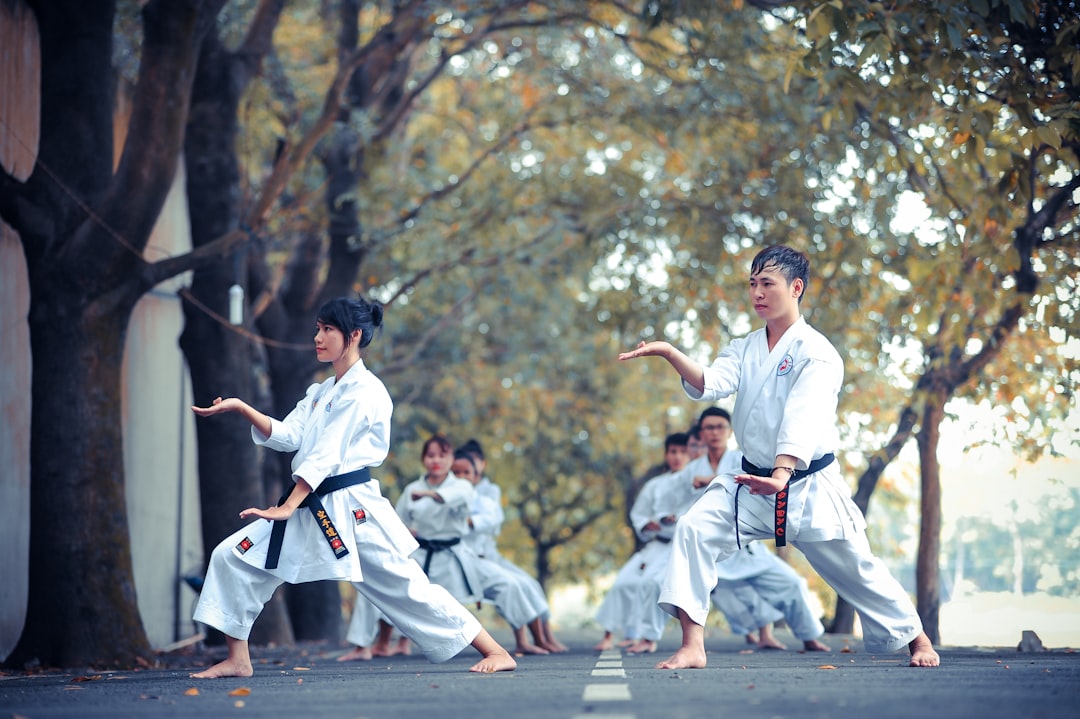Martial arts uniforms, known as 'gi' or 'keikogi,' are central to the practice of martial arts, transcending mere functional wear to become symbols of tradition and cultural significance. These garments, such as the karate gi, reflect the disciplines' rich history, embodying values like discipline, respect, and the warrior ethos. The structured jacket and trousers with tightly fastened ankles symbolize formality, humility, and readiness. Beyond their practical use in allowing full range motion for techniques like those in karate, these uniforms are deeply imbued with cultural narratives, with each component carrying historical meaning. The white color of many gi represents purity and commitment to maintaining noble intentions alongside technical excellence. As martial arts have evolved into globally recognized sports, the karate gi has adapted, balancing tradition with modern athletic demands, now crafted from lightweight materials that offer both resilience and comfort. Global standards for these uniforms exist, with each martial art having its own standardized attire like the judogi in judo, emphasizing the interplay between historical significance and contemporary functionality. When selecting a karate gi, comfort, durability, and respect for tradition are paramount, as they not only honor the discipline but also enhance the learning experience by facilitating flexible movement and optimizing training effectiveness, making them a key consideration for any practitioner.
Martial arts uniforms serve as a bridge between practitioners and their discipline, each garment a reflection of tradition and respect for the art. This article delves into the specific attire of karate: the Gi. From its historical roots to contemporary usage, we explore the significance of this garb within the practice of karate. We will examine the evolution of karate uniforms, compare them with other martial arts uniforms, and provide guidance on selecting the ideal Gi for your training needs. Join us as we unravel the essence of tradition encapsulated in martial arts uniforms.
- The Essence of Tradition: Understanding the Significance of Martial Arts Uniforms
- Gear for Discipline: Exploring the Components and Symbolism of Karate Gi
- The Evolution of Karate Uniforms Over Time
- Global Standards: Commonalities and Differences in Various Martial Arts Uniforms
- Selecting Your Gi: Tips for Choosing the Right Karate Uniform
The Essence of Tradition: Understanding the Significance of Martial Arts Uniforms

Martial arts uniforms are more than mere garments; they encapsulate the rich traditions and history of the martial arts themselves. These attire pieces, often referred to as ‘gi’ or ‘keikogi’ in Japanese martial arts, serve as a tangible connection to the past, symbolizing discipline, respect, and the warrior spirit. They are designed to facilitate movement while also signifying the practitioner’s commitment to the art. What do the various elements of a martial arts uniform represent? The jacket, for instance, with its structured design, represents formality and respect for oneself and one’s opponent. The trousers, often drawn tight at the ankle, symbolize humility and readiness to stand firm in all situations. Are these uniforms simply functional or do they hold deeper cultural significance? They are indeed deeply rooted in cultural tradition; each piece of the uniform carries a story, a nod to the practices from which martial arts have evolved. The traditional white color of many gi, for example, signifies purity and a clean slate, challenging practitioners to be as pure in their intentions as they are in their technique. Martial arts uniforms, therefore, are not just a uniform but a testament to the values upheld by martial arts disciplines worldwide.
Gear for Discipline: Exploring the Components and Symbolism of Karate Gi

When engaging in karate, the practitioner wears a garment that is both functional and steeped in significance: the karate uniform, commonly known as a gi. This traditional martial arts uniform is not merely a garb but a symbol of discipline, respect, and the spirit of the martial art. The gi consists of a jacket, trousers, and a belt, each component serving a unique purpose. The jacket, with its open front and straight lines, allows for a full range of motion, essential for the fluid execution of karate techniques. The trousers, typically featuring a drawstring waistband, provide flexibility and ease of movement during practice and sparring. Together, these elements enable the practitioner to move with efficiency and precision on the dojo floor.
The symbolism embedded in the gi extends beyond its utilitarian aspects; it reflects the wearer’s rank and progress within the discipline. The belt, or obi, tied around the waist, is perhaps the most significant symbol. It signifies the student’s dedication and the journey thus far, with each color representing different stages of mastery. From the white belt, denoting a beginner, to the black belt, signifying advanced proficiency and mastery over both the body and mind, the belt becomes a testament to the practitioner’s commitment to the martial art of karate. Martial arts uniforms like the gi serve as a daily reminder of the principles of karate, fostering an environment where respect, humility, and self-improvement are paramount.
The Evolution of Karate Uniforms Over Time

Karate, as a discipline, has a rich history that is mirrored in the evolution of its attire. Traditionally, practitioners wore simple cotton or hemp garments known as “dogi” or “gi,” which were functional and allowed for ease of movement during practice. Over time, these martial arts uniforms have undergone subtle changes to meet the demands of both functionality and style within the realm of karate training. What began as loose-fitting, plain garments has transformed into a standardized outfit recognized globally in competitions and dojos alike.
The modern karate gi is characterized by its lightweight material, usually cotton or a cotton blend, which offers both durability and comfort to the wearer. It consists of a jacket, trousers, belt (obi), and sometimes a cushioned jacket for added protection during sparring. The evolution of these martial arts uniforms reflects not only the changing needs of karateka but also the global spread of the sport. How have the materials and design of karate uniforms changed over the years? The answer lies in the balance between traditional elements and contemporary improvements, aimed at enhancing performance while maintaining the cultural integrity of the practice. Today’s karate gi is a testament to this harmonious blend, serving both as a symbol of the martial art’s heritage and as a practical piece of athletic equipment.
Global Standards: Commonalities and Differences in Various Martial Arts Uniforms

Martial arts uniforms serve as a cornerstone in the practice of martial arts, providing both functional and symbolic roles. Global standards for these uniforms, often referred to as gis or keikogi in karate, do share common elements, yet they also exhibit distinct differences reflective of their respective martial art traditions. Typically, a martial arts uniform is designed for mobility, comfort, and durability, allowing practitioners to execute techniques without restriction while withstanding the rigors of training. Does every martial art have a standardized uniform? Yes, each martial art tradition has a specific type of uniform that practitioners are encouraged to wear during training to maintain consistency and respect for the discipline. For instance, judo practitioners don a judogi, which is slightly heavier than a karate gi due to its need to accommodate various throws and grappling techniques. Are there any variations in the design or materials of these uniforms? Absolutely, while the basic structure—a set of trousers and a jacket with a belt—remains consistent across different martial arts, the specifications for the fabric, color, and cut can vary widely. This is partly due to the influence of cultural practices and the specific demands of each discipline within the broader realm of martial arts.
Selecting Your Gi: Tips for Choosing the Right Karate Uniform

When selecting your martial arts uniform, also known as a gi, for karate practice, it’s crucial to consider several factors to ensure comfort, durability, and adherence to traditional practices. The gi is more than just a garment; it’s a symbol of respect for the discipline and the art of karate. Opting for high-quality martial arts uniforms is essential for both beginners and seasoned practitioners alike. They not only withstand the rigorous nature of karate training but also contribute to a better learning experience. The fabric should be lightweight yet sturdy, allowing for ease of movement while providing enough structure to hold its shape during techniques like kicks and blocks. Consider the weave and material; a cotton or cotton blend is preferred for breathability and flexibility. Does the uniform comply with your dojo’s requirements? Different schools of karate may have specific recommendations or rules regarding their students’ attire. Are you aware of these regulations? Ensuring your gi meets both functional and traditional standards will not only demonstrate your respect for the art but also help you perform at your best during practice and competition. Remember, the right martial arts uniform can make a significant difference in your training experience.
In conclusion, the karate uniform, known as a Gi, serves as more than mere attire; it encapsulates the essence of tradition and discipline inherent in martial arts practice. Throughout history, martial arts uniforms have evolved, adapting to serve both functional and symbolic purposes while maintaining their role in unifying practitioners globally. Whether one is new to the dojo or a seasoned martial artist, understanding the significance of these uniforms and choosing the right Gi is crucial for honoring the martial arts legacy and embracing its rich tapestry of culture and history. As a final note, the Gi not only facilitates practice but also pays homage to the martial arts’ origins, making it an integral part of every practitioner’s journey in the martial arts uniforms realm.
